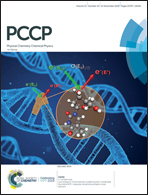Light-activated inorganic CsPbBr2I perovskite for room-temperature self-powered chemical sensing†
Abstract
Halide perovskite materials are excellent light harvesters that have generated enormous interest for photovoltaic technology and an increasing number of other optoelectronic applications. Very recently, their use for miniaturized chemical sensors has shown a promising room-temperature response. Here, we present some insights on the use of CsPbBr2I (CPBI) perovskites for self-powered room-temperature sensing of several environmentally and medically relevant compounds demonstrating rapid detection of down to concentrations of 1 ppm. Notably, the photocurrent of these self-powered CPBI-based devices increases under exposure to both reducing (e.g. acetone, propane) and oxidizing (e.g. NO2, O2) gas molecules and decreases rapidly upon reverting to an inert atmosphere. In situ photoluminescence (PL) analysis of the CPBI during exposure to oxidizing molecules reveals a strongly increased PL intensity and longer lifetime indicating a prevalent role of CPBI trap states in the sensing mechanism. These findings provide new insights for the engineering of perovskite-based materials for their future chemical sensing applications.



 Please wait while we load your content...
Please wait while we load your content...